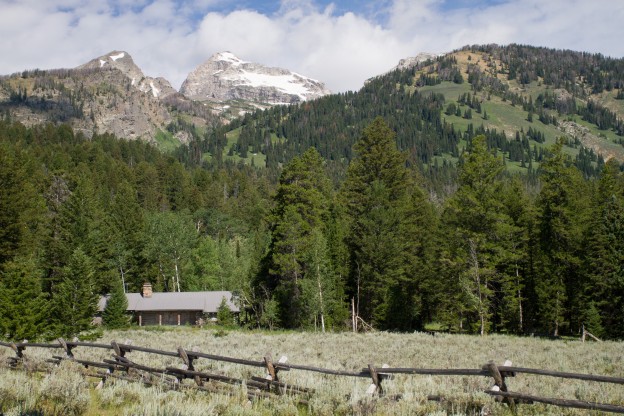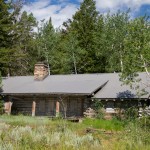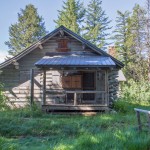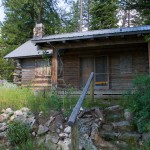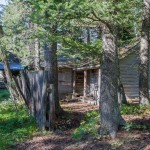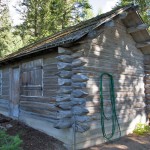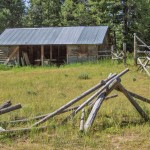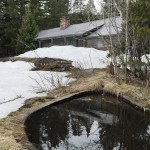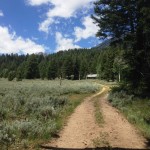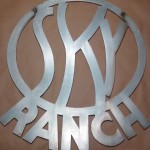- Sky Ranch. Photo by Samantha Ford
- The Grand. Photo by Samantha Ford
- The Grand. Photo by Samantha Ford
- Aunt Hill. Photo by Samantha Ford
- The Grand and Ray & Anna’s cabins. Photo by Samantha Ford
- Ray & Anna’s cabin. Photo by Samantha Ford
- Barn and corral at Sky Ranch. Photo by Samantha Ford
- Sky Ranch in April. Photo courtesy of the Balderston family.
- Sky Ranch Road. Photo courtesy of the Balderston family.
- Sky Ranch sign. Photo courtesy of the Balderston family.
Sky Ranch was the life-long dream of William Balderston II, who first arrived in Jackson Hole at 15 years old in 1912. The summer between his junior and senior high school years, Bill was working on a survey for the Oregon Short Line Railroad that held a right-of-way between Green River, Wyoming and Yellowstone’s south entrance. He traveled on the infamously dangerous survey road lining Hoback Canyon. After the early death of his father in 1913, Bill scrapped plans for attending West Point in New York. Instead, he found work with the Reclamation Service on the third Jackson Lake Dam project, returning to Jackson Hole in 1914. Known to have amateur photography skills, Bill was given a 8×10 Century View camera with the title “progress photographer.” Taking his job seriously, Bill diligently documented the Jackson Lake Enlargement Project, leaving behind a large collection of photographs. It is thought that Bill constructed the first dark room in the valley at Moran to develop his photographs. Upon the completion of the project in 1915, Bill left the valley and pursued a successful career in civil engineering. His work is significant for the introduction of radios in personal automobiles and radar equipment in airplanes. In 1946, Bill became the Executive Vice President of Philco, retiring in 1957 as President. In 1947 Bill received the Certificate of Merit from President Truman for his contributions to developing airplane radar technology for World War II.
Despite spending several decades away from the valley, Jackson Hole was never far from his mind. Like many, he found the valley to be an inspiring place and vowed to return. He spoke often of his desire to own land there, and to create a private ranch for his family. After hearing the story so many times, his wife Susan, called it his “dream in the sky.” In 1948, the Balderston family traveled back to Jackson Hole as dudes at the White Grass Dude Ranch. The family fell in love with the valley and upon their return in 1952, Bill’s big plans would finally take shape. He began to scout the valley to find land that could serve as his dream ranch. Upon hearing his plans, White Grass owner Frank Galey offered to sell a small piece of the northwest portion of his land to Bill. The property would total 13 acres, nestled among a stand of Douglas Fir with a commanding view of the White Grass meadow and the Gros Ventre Range.
Construction began on Bill’s dream “Sky Ranch” in the fall of 1952 and by the following summer, the family moved in. During the construction process, the Balderstons paid Frank Galey to oversee the process. The two families would maintain a close neighborly relationship over the next several decades. The property was designed by Philadelphia architect John Arnold Bower and the work was completed by local contractor Jack Kranenberg. They constructed a main cabin, two sleeping cabins, a bathhouse and a barn with corrals. Unlike the other architect-designed properties in the valley, this ranch was designed to be a quiet family retreat. There was no need for impressing distinguished guests as the natural environment best accomplished that task. The property was designed specifically with the natural beauty of the valley in mind, the imposing Tetons behind the ranch and the Gros Ventre Range as the view shed.
Despite being away from the valley during the construction, Balderston remained committed to the process. He was aware of the impact his ranch would have on the landscape and wrote detailed instructions to ensure the buildings would remain low to the ground and remain nearly invisible between the trees. Minimal trees were removed and minimal landscaping or grading was performed. These methods were highly unusual for the valley, as lots were cleared and buildings arranged in an open cluster. Each of Balderston’s buildings were designed so that no building could be seen from the interior of another.
Jack Kranenberg, the local contractor hired a skilled crew of Norwegians to construct the log buildings. Kranenberg himself was well known throughout the valley for his skill with log. The buildings were modeled in the Rocky Mountain Rustic style that mirrors early homestead architecture. In the case of Sky Ranch, skilled craftsman were responsible for choosing each log for its shape and size to create a uniform appearance. Each building was designed to unique specifications, with below grade foundations and steeply pitched roofs to allow snow to fall off. Each of the chimneys were constructed with stone sourced from the Gros Ventre slide debris field. Few materials were wasted, the ends of logs were used as flat spherical patio paving, rather than additional stone. The unusual level of care and planning undertaken to construct these buildings is still apparent today in their unused state.
The Balderston family spent every summer on the property starting in 1953 until the termination of the life lease in 2005. Over the years, the property served as additional “over flow” space for the White Grass and in turn, the Balderstons were welcome to take part in the White Grass recreation and entertainment. During the summers the family rented horses that they kept in the barn, situated on the northeast corner of the property. Bill wanted to make sure that this family enjoyed the wild beauty of the valley, and riding lessons were undertaken in the winter to prepare for summer. Camping, hiking, fishing, pack trips, cookouts and the rodeo were mainstays for the family. The ranch served as a connective link between family members and outdoor adventure. As the family grew and grandchildren started visiting the property, they would grow up with an appreciation for nature.
Today, Sky Ranch is almost identical to the appearance it had in 1953 when the Balderston family first moved in. The cabins retain a high degree of integrity, with minimal changes to the original buildings. In 1969 an additional log cabin was constructed from a kit to create more room for the growing family. The property still conveys the same sense of peace in natural beauty that the Balderstons so enjoyed.
TIMELINE
1912: William Balderston II first arrives in Jackson Hole to work on a survey project in Hoback Canyon.
1914: Balderston returns to Jackson Hole to work as project photographer on the Jackson Lake Dam Enlargement Project at Moran. He constructs the first known darkroom in the valley.
1915: Balderston departs the valley, but promises to return and to own a ranch.
1948: Keeping a 33-year promise, Balderston returns to Jackson Hole with his family to vacation at the White Grass Dude Ranch.
1952: On a visit to the White Grass, Balderston is approached by ranch owner Frank Galey to purchase a small parcel of land in the ranch’s northwestern corner. Construction begins that fall on Sky Ranch.
1953: The Balderston family spends their first summer at their ranch.
1969: “Sky Bunk” is constructed to create additional space for the growing family.
1982: The Sky Ranch is sold to Grand Teton National Park with a life lease.
2005: The life lease ends and Grand Teton National Park assumes management of the ranch.
Text by Samantha Ford, Director of Historical Research and Outreach



